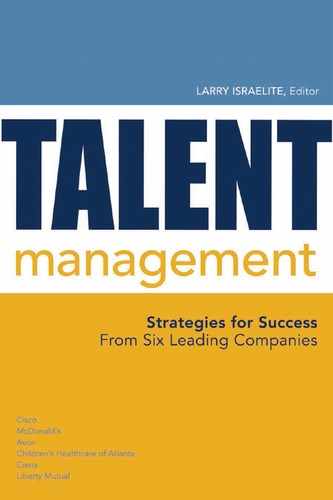References
ASTD (American Society for Training&Development). 2009a. Talent Management Practices and Opportunities. Alexandria, VA: ASTD.
http://www.i4cp.com/contact/download/media/talent management survey findings/contact_download.
———.2009b.The New Face of Talent Management: Making Sure Your Employees Really Are Your Most Important Asset. ASTD whitepaper.
http://www.astd.org/NR/rdonlyres/AC467C24=98B2=4613=8A95=10
86C7E3044D/0/010917TalentMgmtWP5.pdf.
Bersin,Josh.2007a. High-Impact Talent Management: Trends, Best Practices and Industry Solutions. Oakland: Bersin & Associates.
———. 2007b. The Role of Competencies in Driving Financial Performance. Oakland: Bersin & Associates.
Blanchard,Ken,and Sheldon Bowles.1993.Raving Fans:A Revolutionary Approach to Customer Service. New York: William Morrow.
Bossidy, Larry, and Ram Charan. 2002. Execution: The Discipline of Getting Things Done. New York: Random House.
Brinkerhoff, Robert O. 2003. The Success Case Method: Find Out Quickly What’s Working and What’s Not. San Francisco: Berrett-Koehler.
Cameron, Kim S., and Robert E. Quinn. 2005. Diagnosing and Changing Organizational Culture: Based on the Competing Values Framework. San Francisco: Jossey-Bass.
Easterby-Smith, Mark, Luís Aráujo, and John G. Burgoyne. 1999. Organizational Learning and the Learning Organization: Developments in Theory and Practice. London: Sage.
The Economist. 2006. A Survey of Talent. October 7.
Effron, Marc, Shelli Greenslade, and Michelle Salob. 2005. Growing Great Leaders: Does It Really Matter? Human Resource Planning Journal 28,no.3(September):18–23.
Goldsmith, Marshall. 2006. Try Feedforward Instead of Feedback. In Coaching for Leadership, ed. M. Goldsmith and L. Lyons. San FranciSan Francisco: Pfeiffer.
Hamel, Gary, and Bill Breen. 2007. The Future of Management. Boston:Harvard Business Press.
Hammonds, Keith H. 2007. Why We Hate HR. Fast Compan December 19
http://www.fastcompany.com/magazine/97/open_hr.html.
Hunter, J. E., F. L. Schmidt, and M. K. Judiesch. 1990. Individual Differences in Output Variability as a Function of Job Complexity. Journalof Applied Psychology 75, no. 1: 28–42.
Jones, C. 1986. Programming Productivity. New York: McGraw-Hill.
Lamoureux, Kim. 2009. High-Impact Succession Management: Best Practices,Models, and Case Studies in Organizational Talent Mobility. Oakland: Bersin & Associates.
Leitch, Lord Sandy. 2006. UK Skills: Prosperity for All in the Global Economy—World Class Skills. London: Her Majesty’s Treasury.
http://www.hm-treasury.gov.uk/d/leitch_finalreport051206.pdf.
Levensaler, Leighanne. 2008a. The Essential Guide to Performance Management Practices, Part 1. Oakland: Bersin & Associates.
———.2008b.The Essential Guide to Performance Management Practices, Part 2. Oakland: Bersin & Associates.
———.2008c.Talent Management Suites: Market Realities, Implementation Experiences and Vendor Profiles. Oakland: Bersin & Associates.
Momentum Executive Development. 2007.Talent and Leadership Practices 2007.Reading, U.K.: Business Momentum Ltd.
http://www.businessmomentum.com/TalentandLeadership/69/Download
theMomentum.html.
O’Leonard,Karen.2008.2008 Talent Management Factbook: Global Trends,
Facts and Strategies in Corporate Talent Management.Oakland: Bersin & Associates.
Schein, Edgar H. 2004.Organizational Culture and Leadership. San Francisco:Jossey-Bass.
Stern, Stefan. 2007. Why Managers Need to Engage with Grumpy Employees. Financial Times. May 14.
Yates, Richard. 1961. Revolutionary Road. New York: Atlantic–Little,Brown.
